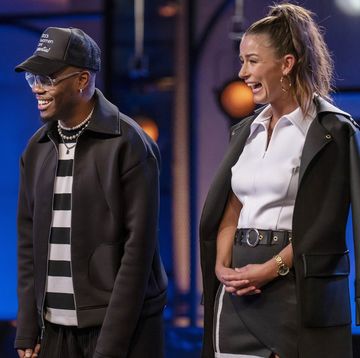Issa Rae is seemingly everywhere all at once lately: President Barbie in one of the summer’s shattering blockbusters. Jessica Drew in Spider-Man: Across the Spider-Verse, released in June. Host and executive producer of Max’s current iteration of Project Greenlight, ushering in new voices. Launching Raedio’s (her record label and audio media company) first-ever talk show last month. And a whole host of upcoming projects and initiatives. She’s dominated the industry since breaking through seven years ago with her HBO series Insecure, which recently landed on Netflix—one of such HBO shows to do so—and has long been praised for its authentic portrayal of Black life. At every step, the multi-hyphenate has remained intentional about championing representation in media and paving the way for the next generation of Black creatives.
Yesterday, she continued her dedication to bridging gaps with the culmination of Shipt’s first-ever student internship program. It’s a project that Rae, who serves as a collaborator for the grocery delivery service, partnered on alongside Shipt’s chief marketing officer Alia Kemet. Rae said the program, which kicked off in mid-May, was created to empower up-and-coming diverse talent in the creative space beginning at the college level.
“This was such a seamless collaboration,” Rae tells me, “because it aligns with so much of my mission as a creator, as an artist, as an employer—just across the board.”
More From ELLE

It’s also intended to cap the widening gap of artists of color in varying creative functions. In advertising, for example, only 7 percent of professionals are Black Americans. Of the more than 2,000 screenwriters employed and represented by the Writers Guild of America West—the union representing the majority of movie and television writers—30 percent are women, and around 20 percent are people of color. For women of color? That comes to just about 10 percent. For film directors, 83 percent are white.
For the inaugural internship, four Howard University students—rising juniors Avery Harrell, Serenity Owens, Gavin Kelley, and rising sophomore Kayla Collins—who are interested in creative arts and advertising were selected. They were tasked with developing a national commercial for Shipt’s new student membership offering.
Over three months, the four interns worked with industry heavyweights, including Rae, Kemet, and director Lawrence Lamont to develop a 30-second commercial, now live. The students not only took charge of the video’s ideation, direction, and editing but further showcased their talents by starring in it.
Their ad was revealed in Times Square last night at an event hosted by Shipt, where the students were surprised to see their work beaming from the iconic tourist hotspot. The students, hailing from Louisiana, Atlanta, and D.C., each thought they were attending a media event to launch the ad campaign but were surprised to see Rae at The R Lounge at The Renaissance overlooking Times Square and their work displayed prominently on one of the giant screens on the corner of West 47th Street and Broadway.
And this is only the beginning for the program, Rae tells me. With the success of the Howard University pilot, the plan is to expand nationwide, providing more students with hands-on experience. “What I love about the Shipt leadership is that they are very committed to making a change,” she says. “That’s something that I’ve seen working with them one on one with opportunities like this. The CMO and CEO both come from HBCUs and are very intentional about just making sure that they’re forging a path forward. And I really respect that.”
Rae has long been a vocal advocate for such inclusion and hopes programs like this would inspire students to pursue the arts, even now when the industry is in turmoil.
“Hopefully, it’ll provide more opportunities,” Rae says of the ongoing writers and actors strikes, “and that Black creators are being kept in mind. I remember the last strike [of 2007-2008], that was my biggest fear. [Because] post that strike, we just had a dearth of Black content.”
Below, Rae delves into the new initiative and speaks about the volatility the industry is currently wading through.
Tell me about your inspiration behind partnering on this internship program and what you hope the students take away from it.
This is a program with the intention of giving more opportunities to underrepresented voices. And my company is comprised of a lot of Howard students; though I didn’t go there myself, they are central to my company. So, to work with the school and give students an opportunity to create a national commercial is right up my alley. It made the public partnership [with Shipt] that much more fulfilling.
I hope the students understand they have mentors for the foreseeable future as long as they continue to pursue this—even if they don’t. I also love that they have a quality project on their resume. The commercial speaks for itself, and they can reference that as a ticket for more opportunities. I’m proud of that.
Now that they’ve seen what each other has to offer, I also hope this will be the first of many projects of this scale for them and that they’ll continue to keep in touch and collaborate with one another.
You’re so intentional about ushering in the next generation of creatives. Why has this been your focus since you broke through?
It comes from what I haven’t seen. It also comes from a desire to make what I want to see possible. Once you have the agency to make a change, it’s on you to do so, especially if you’re going to complain—and I complain a lot. So to have the opportunity to be able to do something about it, why not?
There remains a glaring diversity and inclusion gap. Why do you think that is?
That’s why this internship program was so special because it targets students who are in the creative and advertising industries. So that’s already part of making a change.
The other thing is, part of the issue is that some people and organizations think that inclusion alone is enough. So just because you’re like, “Oh, we hired a Black person,” that’s it; we’ve done diversity and inclusion. If there’s no mentorship or guidance to see that person promoted or to make sure there are other opportunities outside of the one they’ve been given, it's a lost cause.
And, of course, it’s up to the people, too, to make the most of their opportunities. But sometimes, you could be working hard and doing all the right things, and you’re met with an instance of nepotism or legacy hires or being overlooked repeatedly. So it’s really important to have programs in place that are dedicated to making sure people are trained beyond just the sole opportunity they're given.
Sticking with that for a moment—how could companies and colleges get more intentional about bridging that gap and fostering a diverse talent and leadership pipeline?
I think paid internships are a necessity. When I was coming up, there were these free programs that were a bit exploitative, but I still took advantage of them. They get you in the door, but they wouldn’t get me any farther. So colleges and companies should make sure that there’s a follow-up program.
I remember going to an advertising conference—it was called ADCOLOR. What I loved about that particular conference was that they were placing graduates into Fortune 500 companies with internship and job opportunities. Then, they followed up with those employees to make sure that they were thriving in their respective environments. That follow-through is a necessary component. Don’t send people off to the wolves; ensure their success.
Every three years, both East and West branches of the Writers Guild of America—which represent about 11,500 film and television writers—negotiate new contracts with major studios. And this year, Hollywood has come under siege with one of the largest labor disputes in the nation. What are your thoughts on the strike? How do you feel it is affecting Black creatives?
Sometimes, we lead the causes of these strikes, and then we’re an afterthought when the deals are made. So, while I fully support it, I want to make sure that people of color are getting their due in the aftermath of it and in the winning.
I also don’t think the strike will deter Black creatives from wanting to enter the space. It will inspire them because the WGA is generally fighting for a fair wage. These are things that are felt industry-wide. It’s all for the better. So, Black creators can rest assured knowing that there’s an industry fighting for them to get their fair due and fair wages and not trying to replace them.
That’s been the heart of the whole fight, specifically with the Writers Guild. They want to make sure you can make a living as a writer, and that’s what the AMPTP [Alliance of Motion Picture and Television Producers] seems to be trying to prevent.
Along those same lines, how have you been encouraging rising Black creatives during this time? How have you been staying encouraged?
It’s obviously a challenging time. There’s a community of us on text standing by each other. We all want to be working, but we all want to make sure that everybody we’re working with is fairly paid and acknowledged. So for us, it’s about being each other's venting systems and support systems and making sure that, outside of this difficult moment, we’ll still be looking out for one another because that kind of support is not always guaranteed in the industry.
What is the one piece of advice you’d give your younger self—and by extension, those looking to you as a North Star—before your big break?
I would tell my younger self to look around and take stock of all the things you’re gonna miss about this past version of yourself. There are some things you may take for granted now that you wish you hadn’t. And there are certain simple things—even relationships—that you take for granted that I would take stock of and make sure I preserve them. So many things change in your trajectory. At times in a good way and sometimes in a bad way.
As you look back on that career trajectory, what has driven you? And what do you hope is your lasting impact?
I just want to make things that are people’s favorite — specifically, my people’s favorite. I think about the projects that have led me here, that have impacted me and shaped me. If I could do the same for another me or my friends and family, then I’m satisfied.
This interview has been edited and condensed for clarity.
Rita Omokha is an award-winning Nigerian-American writer and journalist based in New York who writes about culture, news, and politics.














